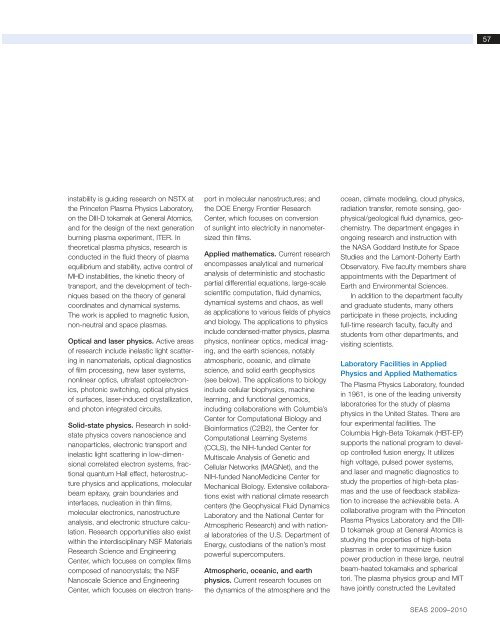2009-2010 Bulletin â PDF - SEAS Bulletin - Columbia University
2009-2010 Bulletin â PDF - SEAS Bulletin - Columbia University
2009-2010 Bulletin â PDF - SEAS Bulletin - Columbia University
You also want an ePaper? Increase the reach of your titles
YUMPU automatically turns print PDFs into web optimized ePapers that Google loves.
57<br />
instability is guiding research on NSTX at<br />
the Princeton Plasma Physics Laboratory,<br />
on the DIII-D tokamak at General Atomics,<br />
and for the design of the next generation<br />
burning plasma experiment, ITER. In<br />
theoretical plasma physics, research is<br />
conducted in the fluid theory of plasma<br />
equilibrium and stability, active control of<br />
MHD instabilities, the kinetic theory of<br />
transport, and the development of techniques<br />
based on the theory of general<br />
coordinates and dynamical systems.<br />
The work is applied to magnetic fusion,<br />
non-neutral and space plasmas.<br />
Optical and laser physics. Active areas<br />
of research include inelastic light scattering<br />
in nanomaterials, optical diagnostics<br />
of film processing, new laser systems,<br />
nonlinear optics, ultrafast optoelectronics,<br />
photonic switching, optical physics<br />
of surfaces, laser-induced crystallization,<br />
and photon integrated circuits.<br />
Solid-state physics. Research in solidstate<br />
physics covers nanoscience and<br />
nanoparticles, electronic transport and<br />
inelastic light scattering in low-dimensional<br />
correlated electron systems, fractional<br />
quantum Hall effect, heterostructure<br />
physics and applications, molecular<br />
beam epitaxy, grain boundaries and<br />
interfaces, nucleation in thin films,<br />
molecular electronics, nanostructure<br />
analysis, and electronic structure calculation.<br />
Research opportunities also exist<br />
within the interdisciplinary NSF Materials<br />
Research Science and Engineering<br />
Center, which focuses on complex films<br />
composed of nanocrystals; the NSF<br />
Nanoscale Science and Engineering<br />
Center, which focuses on electron transport<br />
in molecular nanostructures; and<br />
the DOE Energy Frontier Research<br />
Center, which focuses on conversion<br />
of sunlight into electricity in nanometersized<br />
thin films.<br />
Applied mathematics. Current research<br />
encompasses analytical and numerical<br />
analysis of deterministic and stochastic<br />
partial differential equations, large-scale<br />
scientific computation, fluid dynamics,<br />
dynamical systems and chaos, as well<br />
as applications to various fields of physics<br />
and biology. The applications to physics<br />
include condensed-matter physics, plasma<br />
physics, nonlinear optics, medical imaging,<br />
and the earth sciences, notably<br />
atmospheric, oceanic, and climate<br />
science, and solid earth geophysics<br />
(see below). The applications to biology<br />
include cellular biophysics, machine<br />
learning, and functional genomics,<br />
including collaborations with <strong>Columbia</strong>’s<br />
Center for Computational Biology and<br />
Bioinformatics (C2B2), the Center for<br />
Computational Learning Systems<br />
(CCLS), the NIH-funded Center for<br />
Multiscale Analysis of Genetic and<br />
Cellular Networks (MAGNet), and the<br />
NIH-funded NanoMedicine Center for<br />
Mechanical Biology. Extensive collaborations<br />
exist with national climate research<br />
centers (the Geophysical Fluid Dynamics<br />
Laboratory and the National Center for<br />
Atmospheric Research) and with national<br />
laboratories of the U.S. Department of<br />
Energy, custodians of the nation’s most<br />
powerful supercomputers.<br />
Atmospheric, oceanic, and earth<br />
physics. Current research focuses on<br />
the dynamics of the atmosphere and the<br />
ocean, climate modeling, cloud physics,<br />
radiation transfer, remote sensing, geophysical/geological<br />
fluid dynamics, geochemistry.<br />
The department engages in<br />
ongoing research and instruction with<br />
the NASA Goddard Institute for Space<br />
Studies and the Lamont-Doherty Earth<br />
Observatory. Five faculty members share<br />
appointments with the Department of<br />
Earth and Environmental Sciences.<br />
In addition to the department faculty<br />
and graduate students, many others<br />
participate in these projects, including<br />
full-time research faculty, faculty and<br />
students from other departments, and<br />
visiting scientists.<br />
Laboratory Facilities in Applied<br />
Physics and Applied Mathematics<br />
The Plasma Physics Laboratory, founded<br />
in 1961, is one of the leading university<br />
laboratories for the study of plasma<br />
physics in the United States. There are<br />
four experimental facilities. The<br />
<strong>Columbia</strong> High-Beta Tokamak (HBT-EP)<br />
supports the national program to develop<br />
controlled fusion energy. It utilizes<br />
high voltage, pulsed power systems,<br />
and laser and magnetic diagnostics to<br />
study the properties of high-beta plasmas<br />
and the use of feedback stabilization<br />
to increase the achievable beta. A<br />
collaborative program with the Princeton<br />
Plasma Physics Laboratory and the DIII-<br />
D tokamak group at General Atomics is<br />
studying the properties of high-beta<br />
plasmas in order to maximize fusion<br />
power production in these large, neutral<br />
beam-heated tokamaks and spherical<br />
tori. The plasma physics group and MIT<br />
have jointly constructed the Levitated<br />
<strong>SEAS</strong> <strong>2009</strong>–<strong>2010</strong>







